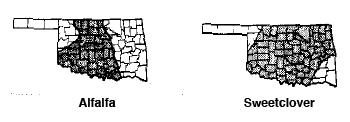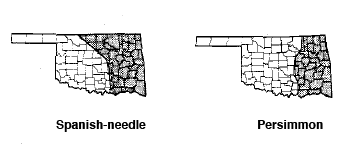Nectar and Pollen Plants of Oklahoma
There are few places in Oklahoma where surplus honey cannot be produced if bees are properly managed. However, locations only a few miles apart produce honey crops varying considerably in size. Therefore, greater profit might result if beekeepers give more attention to pollen and nectar sources near their apiaries. Some plants furnish only pollen and others only nectar, but the majority of plants supply both. Pollen is a source of protein, the tissue-building food for bees; nectar, a carbohydrate, is the energy food.
Experienced beekeepers have learned that in some years the ability of plants to produce nectar and pollen varies considerably. These variations may be the result of climatic conditions (droughts), changes in agricultural crops and practices, damage by herbivorous insects, and the installation of irrigation projects.
Beekeepers should note when the relative abundance of plants important to the honey bee bloom, how long they remain in bloom, and the effect of weather conditions upon secretion of nectar.
Apiarists and farmers need information to aid them in coordinating honey production in Oklahoma with erosion control, pasture building, cover cropping, and the production of grain, fruit, vegetables, seeds, fiber, and livestock. The following is a list of important nectar and pollen plants of the state, and their dates of blooming.
Table 1. Major Nectar and Pollen Plant Sources of Oklahoma
| Plant Name* | Dates of Bloom |
|---|---|
| Alfalfa (N) | May 10 to Frost |
| Cotton (N&P) | July 10 to Frost |
| Hairy vetch (N&P) | April 20 to July 31 |
| Persimmon (N&P) | May 15 to June 15 |
| Plains sage (N&P) | June 1 to October |
| Smartweed (N&P) | July 1 to October |
| Spanishneedle (N&P) | Aug. 1 to Frost |
| Vitex (N&P) | May 15 to Frost |
| White sweetclover (N&P) | May 5 to July 25 |
| Yellow sweetclover (N&P) | April 20 to July 10 |
Table 2. Minor Nectar and Pollen Plant Sources of Oklahoma
| Plant Name* | Dates of Bloom |
|---|---|
| Bee bee tree (N&P) | July 1 to August 31 |
| Bindweed (N) | May 15 to Sept. 30 |
| Black locust (N&P) | April 10 to May 20 |
| Broomweed (N&P) | July 5 to Nov. 10 |
| Dandelion (N&P) | April 1 to June 1 |
| Elm (P) | Feb. 25 to March 25 |
| Lawn clover (N&P) | March 20 to July 1 |
| Lemon monarda (N&P) | June 1 to October |
| Maple (N&P) | Feb. 20 to May 5 |
| Milkweed (N) | May 10 to Sept. 5 |
| Pear (N&P) | March 15 to April 8 |
| Redbud (N&P) | March 10 to April 15 |
| Sand plum (N&P) | March 20 to May 10 |
| Sumac (N&P) | May 10 to August 1 |
| Sunflower (N&P) | July 1 to Frost |
| Tame plum (N&P) | March 20 to May 5 |
| Willow (N&P) | March 20 to April 10 |
Characteristics of Nectar and Pollen Plants
Major Sources
Alfalfa (Medicago sativa) is grown extensively over the entire state. Approximately one-third of honey produced in Oklahoma is from this source. Alfalfa honey is a very light amber to white with a reddish tint. A considerable amount of potential for honey production is not realized because alfalfa is primarily grown for hay and, during early summer, is harvested before full bloom. After July 1, however, farmers often stop cutting hay and leave alfalfa for seed production. The latter is compatible with honey production.
Cotton (Gossypium hirsutum) is one of the major crops of Oklahoma and is generally found in the southern one-half of the state. Cotton is an important nectar and pollen source when grown on rich alluvial soils. On lighter sandy soils, it produces little nectar. Cotton honey is white, has good body, and a characteristic cotton flavor. Because of the scarcity of bees in some cotton-growing areas and the frequent use of chemical insecticides, much potential for honey production is lost.
Hairy Vetch (Vicia villosa) produces an abundance of pollen and nectar. This plant may produce nectar for a surplus of honey in some areas of the state. One of the earliest major honey flows is obtained from this plant. The honey is water-white in color with good flavor and is well accepted by the consumer. Due to the early blooming period, bee colonies need to be very strong after the winter season to obtain a surplus from this plant.
Persimmon (Diospyros virginiana) produces large surpluses in the eastern one-third of the state. In fact, persimmon may be one of the state’s major honey-producing plants. Honey produced from it is water-white.
Plains Sage (Salvia coccinea) produces a good source of nectar and a surplus of pollen. The honey is light in color, of good flavor, and has the characteristic monarda flavor. This plant is one of the major honey plants of Oklahoma and is found in abundance south of the Canadian River. Sometimes, falsely referred to as horsemint, this plant begins blooming the latter part of May or first of June.
Smartweed (Polygonum sp.) includes several species from the same genus. This plant grows statewide, usually as a volunteer weed, and produces honey that is dark in color with a characteristic buckwheat flavor and color. Most of this honey is used for wintering bees, but any surplus is readily used in bakeries or by the few people who appreciate the mild buckwheat taste.
Spanishneedle (Bidens bipinnata L.) is a dependable honey plant in northeastern Oklahoma providing a surplus of nectar. The honey is golden in color, with a good flavor.
Vitex (Vitex negunda) is also called summer lilac or chaste tree. This fast growing, multiple-stemmed shrub can reach a height of 12-15 feet. Aromatic whitish-purple spikes bloom all summer. This plant grows well in a wide variety of soil types. This plant is probably a major nectar and pollen source for apiaries in southern Oklahoma.
White sweetclover (Melilotus alba) grows well over the entire state and is also one of the major nectar and pollen producing plants of Oklahoma. It produces honey of good flavor, light color, and good body. White sweetclover blooms about 10-15 days after yellow sweetclover and produces a good surplus of pollen and nectar.
Yellow sweetclover (Melilotus officinalis) grows statewide and is a major source for honey production in Oklahoma. Nectar and pollen sources from yellow sweetclover tend to be 10-15 days ahead of white sweetclover, providing an earlier foraging site for honey bees. A surplus of honey may be obtained from this source; however, many colonies are not ready for the early nectar flow from this plant. Honey from yellow sweetclover is extra white to extra light amber with a mild flavor.
Minor Sources
Among the plants of lesser importance as sources of nectar and pollen in spring brood rearing are dandelion, elm, redbud, plum, willow, maple, locust, and fruit bloom.
Milkweed produces an abundance of pollen and, in some areas, produces a small surplus of nectar. This plant is found in the northeastern and north central counties of the state. Bindweed or tie vine is a very valuable honey plant in many sections of Oklahoma, especially on rich alluvial soils. This plant produces a surplus of white honey.
Sumac is found growing on thousands of acres in all sections of Oklahoma. It produces a surplus of light-colored and well-flavored honey. This plant and bindweed may become of less importance as herbicides are used to remove them from crops and pastures.
Broomweed is found growing statewide on prairies and is a good source of pollen and honey for wintering bees. A strong-flavored, golden-colored honey is usually gathered in September and October. Sunflower is also a good plant for producing pollen and nectar for fall brood rearing.
Eric Rebek
Professor and State Extension Specialist
Phil Mulder
Area Extension Entomologist



